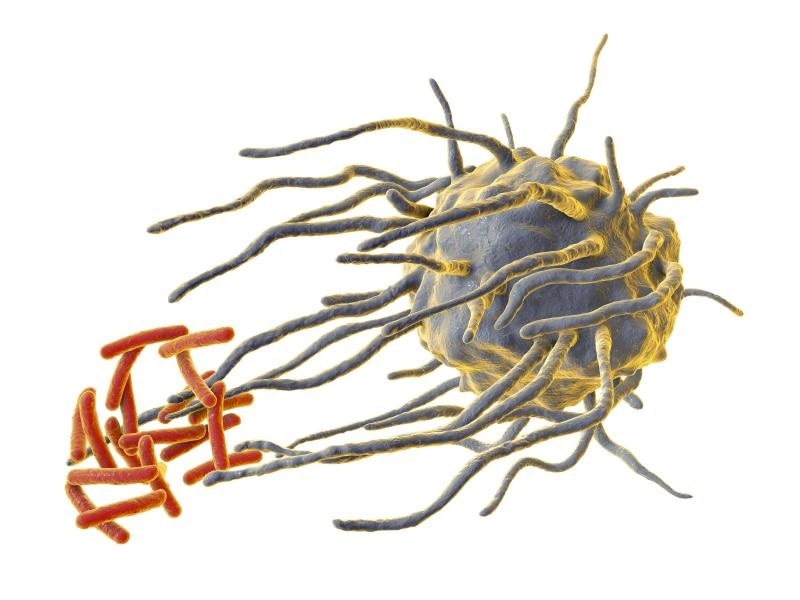According to an analysis of a detailed dataset on cells crucial to the mammalian immune system, humans’ ability to combat diseases may largely depend on day-to-day circadian cycles than previously believed.

Macrophages, the killer cells of our immune system, are controlled by circadian rhythms, but the timing appears to rely upon an unexpected influence. Image Credit: Rensselaer Polytechnic Institute.
Circadian rhythms are, essentially, processes that maintain the human body in tune with the day and night cycles. But malfunctions in circadian rhythms are increasingly linked to many diseases, including Alzheimer’s, cancer, and diabetes.
A study recently published in the Genome Research journal has revealed that the activity of macrophages—that is, cells within the human body that search for and kill invaders, such as bacteria—are likely to time the everyday changes in their reactions to stress and pathogens via the circadian control of metabolism.
In the new research work, Jennifer Hurley, the senior author of the study, and Richard Baruch M.D. Career Development Assistant Professor of Biological Sciences at Rensselaer Polytechnic Institute and her group studied how the concentrations of proteins and RNA in macrophages modify over two days.
We have shown there is an incredible amount of circadian timing of macrophage behavior, but the clock is timing macrophages in unexpected ways”
Jennifer Hurley, Study Senior Author and Richard Baruch M.D. Career Development Assistant Professor of Biological Sciences, Rensselaer Polytechnic Institute
Hurley is also a member of the Center for Biotechnology and Interdisciplinary Studies (CBIS) at Rensselaer Polytechnic Institute.
The circadian system includes a set of central clock proteins that expect the day and night cycle by inducing daily oscillations in enzyme and hormone levels, and finally impacting physiological parameters like the immune response and body temperature.
This unique molecular clock uses a self-regulating cycle of production and decay of proteins to mark time. Within the molecular clock, the “positive” element proteins stimulate the synthesis of the “negative” element proteins, which consequently inhibit the synthesis of positive element proteins until decay occurs in the negative element proteins, thereby producing a negative feedback cycle that takes place once in every 24 hours.
Furthermore, positive element proteins control variations in a considerable number of gene products, called messenger RNA or mRNA for short. Genetic instructions are then transcribed from DNA to mRNA, and these instructions are subsequently used as a recipe for organizing proteins—the functional building blocks of the cell.
For a long time, it has been believed that the levels of every following step could be estimated from the previous ones. But if that was the case, oscillating mRNA would match with the oscillating levels of cellular proteins, and thus, if individuals could monitor mRNA, they would know the kinds of proteins that are controlled in the cell by the circadian clock.
But this analysis demonstrated that this case may not invariably be true. The study of the macrophage dataset demonstrated that there was a significant mismatch between the mRNAs and proteins regulated by the circadian clock.
This information paralleled the 2018 study reported in Cell Systems by the Hurley laboratory, demonstrating that around 40% of oscillating proteins in the fungus and Neurospora crassa—the circadian model system—did not have any corresponding oscillating mRNA.
But the scale of the difference in macrophages really surprised us. Eighty percent of the proteins that oscillate don’t have associated oscillating mRNA in macrophages. That means we were really missing how the clock was timing immunity.”
Jennifer Hurley, Study Senior author and Richard Baruch M.D. Career Development Assistant Professor of Biological Sciences, Rensselaer Polytechnic Institute
In association with the Annie Curtis laboratory at the Royal College of Surgeons in Ireland (RCSI), Hurley’s group was able to estimate and show that it is the clock that controls the metabolism to time the crucial immune functions in macrophages.
To achieve this, the RCSI team followed the energy-producing mitochondria of macrophages, demonstrating the rhythm with which the organelles break apart to create energy and re-combine in a resting phase.
The Hurley lab was then able to demonstrate that the timing of crucial immune processes was regulated by the variations in energy production that emerged from the splitting and merging of the mitochondria.
Our data points to the need to track rhythms on a whole new level. It also means that our bodies are timed by our circadian clocks more than we thought.”
Annie Curtis, Senior Lecturer, Royal College of Surgeons in Ireland
The circadian timing of the immune system holds major implications for disease treatment, human health, and vaccine efficacy.
Jennifer Hurley Discusses Circadian Rhythm Research
Video Credit: Rensselaer Polytechnic Institute.
Source:
Journal reference:
Collins, E. J., et al. (2021) Post transcriptional Circadian regulation in Macrophages Organizes Temporally Distinct Immunometabolic States. Genome Research. doi.org/10.1101/2020.02.28.970715.